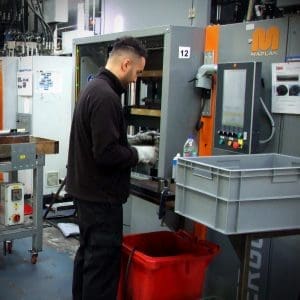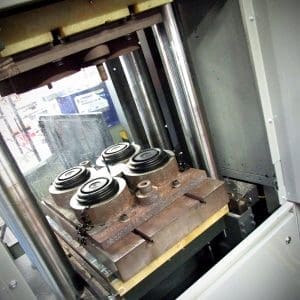Unlocking the Potential of Custom Rubber Moulded Parts: A Comprehensive Overview

Welcome to ‘Unlocking the Potential of Custom Rubber Moulded Parts: A Comprehensive Overview’. In this article, we will embark on a journey to explore the endless possibilities that custom rubber moulded parts can offer.
Custom rubber moulded parts are an essential component in a wide range of industries, including automotive, aerospace, and manufacturing. Whether you need intricate seals, grommets, or even bespoke components, the versatility of rubber moulding allows for the creation of unique parts tailored to your specific needs.
From improving functionality and durability to enhancing performance and reducing costs, custom rubber moulded parts have the power to revolutionise your products. But how do you unlock their full potential.
In this comprehensive overview, we will delve into the various types of rubber moulding processes, such as injection moulding and compression moulding, as well as discuss the benefits and applications of custom rubber moulded parts. We will also explore key considerations when selecting a rubber moulding manufacturer and share expert insights to help you make informed decisions.
Advantages of using custom rubber moulded parts
Custom rubber moulded parts offer numerous advantages over off-the-shelf alternatives. Whether you require specific dimensions, unique shapes, or specialised materials, custom moulding allows for the creation of parts that perfectly match your requirements.
One of the main advantages of custom rubber moulded parts is their ability to improve functionality. By precisely designing parts to fit your equipment or machinery, you can enhance performance and ensure optimal operation. For example, custom rubber seals can provide a watertight and airtight seal, preventing leaks and reducing energy loss.
In addition to functionality, custom rubber moulded parts can also significantly improve durability. By selecting the right materials and manufacturing processes, you can create parts that withstand harsh environments, extreme temperatures, and chemical exposure. This durability translates into reduced maintenance and replacement costs, saving you both time and money.
Another advantage of custom rubber moulded parts is their versatility. Rubber moulding allows for the production of complex shapes and intricate designs that may not be achievable with other materials. This versatility opens up possibilities for innovative product designs and can give you a competitive edge in the market.
Overall, the advantages of using custom rubber moulded parts include improved functionality, enhanced durability, versatility in design, and cost savings. Now, let’s explore some common applications where these custom parts excel.

Common applications of custom rubber moulded parts
Custom rubber moulded parts find application in a wide range of industries due to their versatility and performance. Let’s take a closer look at some of the common applications where these parts excel.
In the automotive industry, custom rubber moulded parts play a crucial role in ensuring vehicle safety and performance. From seals to suspension components and vibration dampers, custom rubber parts help create a comfortable and reliable driving experience. They provide effective sealing against moisture, dust, and noise, as well as absorb shock and vibrations, enhancing overall vehicle performance and longevity.
The aerospace industry also heavily relies on custom rubber moulded parts. These parts are used in aircraft engines, landing gear systems, fuel systems, and more. Custom rubber seals and gaskets help maintain the integrity of critical systems, ensuring safe and efficient operation. The ability to withstand extreme temperatures, high pressures, and various fluids makes custom rubber parts an ideal choice for aerospace applications.
Manufacturing industries, including machinery and equipment manufacturers, benefit greatly from custom rubber moulded parts. These parts are used in machinery assemblies, conveyor systems, and hydraulic equipment, among others.
Custom rubber components provide effective sealing, reduce friction, and absorb shocks, contributing to the smooth operation of industrial equipment.
Other applications of custom rubber moulded parts include medical devices, electrical enclosures, consumer goods, and more. The versatility of rubber moulding allows for the creation of parts that meet specific industry requirements, making them indispensable in various sectors. Now that we understand the applications of custom rubber moulded parts, let’s explore the different types of rubber moulding processes.
The rubber moulding process explained
The rubber moulding process is the key to creating custom rubber moulded parts. There are several different processes used in rubber moulding, each with its own advantages and considerations. Let’s take a closer look at two of the most common types: injection moulding and compression moulding.
Injection moulding is a highly efficient process that involves injecting molten rubber into a mould cavity under high pressure. This process allows for the creation of complex shapes with precise dimensions and intricate details. Injection moulding is suitable for large-scale production and offers fast cycle times, making it ideal for high-volume manufacturing.
On the other hand, compression moulding involves placing pre-measured rubber material into a heated mould cavity and applying pressure until the material cures. This process is well-suited for producing parts with varying thicknesses and requires less expensive tooling compared to injection moulding. Compression moulding is often chosen for smaller production runs or larger, heavier parts.
Both injection moulding and compression moulding have their advantages and considerations, and the choice between the two depends on factors such as part complexity, production volume, and cost considerations. Now, let’s move on to the factors to consider when designing custom rubber moulded parts.



Factors to consider when designing custom rubber moulded parts
Designing custom rubber moulded parts requires careful consideration of several factors to ensure optimal performance and manufacturability. Let’s explore some key considerations that will help you design effective custom parts.
Firstly, it is important to consider the intended function and operating conditions of the part. Understanding the environment in which the part will be used will help determine the appropriate rubber material, hardness, and dimensional requirements. For example, if the part will be exposed to chemicals or extreme temperatures, selecting a compatible rubber material is crucial for long-term performance.
Secondly, the design of the part should take into account the moulding process being used. Injection moulding and compression moulding have different design considerations, such as draft angles, parting lines, and gate locations.
Collaborating with your rubber moulding manufacturer during the design phase can help optimise the part for the chosen moulding process.
Additionally, considering the part’s geometry and complexity is essential. Rubber moulding allows for the creation of intricate shapes and details, but overly complex designs may lead to manufacturing challenges or higher costs. Balancing design complexity with manufacturability is crucial for efficient production.
Lastly, it is advisable to conduct thorough prototyping and testing before finalising the design. Prototyping allows for evaluation of the part’s fit, function, and performance, enabling any necessary design adjustments before moving into full-scale production. Performing testing, such as compression set, tensile strength, and ageing tests, ensures that the part meets the required specifications and quality standards.
By considering these factors during the design phase, you can enhance the functionality, manufacturability, and performance of your custom rubber moulded parts. Now, let’s move on to selecting the right rubber material for your custom moulded parts.

Choosing the right rubber material for your custom moulded parts
Selecting the right rubber material is crucial for the performance and longevity of your custom moulded parts. There are various rubber compounds available, each with its own unique properties and suitability for different applications. Let’s explore some commonly used rubber materials and their characteristics.
Natural rubber (NR) is a popular choice due to its excellent resilience, tear resistance, and low heat build-up. It offers good resistance to abrasion and is suitable for applications requiring high elasticity and flexibility. However, natural rubber is not recommended for use with oils, fuels, or solvents.
Nitrile rubber (NBR) is known for its excellent resistance to oils, fuels, and solvents. It offers good mechanical properties, including high tensile strength and abrasion resistance. NBR is commonly used in automotive seals, gaskets, and O-rings, where resistance to petroleum-based fluids is critical.
Silicone rubber (VMQ) is a high-performance material known for its excellent temperature resistance and flexibility over a wide range. It can withstand extreme temperatures, from -60°C to 250°C, making it suitable for automotive, aerospace, and electrical applications. Silicone rubber also offers good resistance to UV light, ozone, and weathering.
These are just a few examples of commonly used rubber materials. Depending on your specific application requirements, there are numerous other rubber compounds available, such as EPDM, neoprene, and Viton (FKM).
Consulting with your rubber moulding manufacturer will help you select the most suitable material for your custom moulded parts. Now, let’s move on to quality control and testing for custom rubber moulded parts.
Quality control and testing for custom rubber moulded parts
 Ensuring the quality and reliability of custom rubber moulded parts is essential to their performance and longevity. Quality control measures and rigorous testing protocols help identify any defects or deviations from specifications. Let’s explore some key aspects of quality control and testing for custom rubber moulded parts.
Ensuring the quality and reliability of custom rubber moulded parts is essential to their performance and longevity. Quality control measures and rigorous testing protocols help identify any defects or deviations from specifications. Let’s explore some key aspects of quality control and testing for custom rubber moulded parts.
Firstly,it is important to establish clear quality standards and specifications for the parts. This includes defining dimensional tolerances, material properties, and performance requirements. By setting clear expectations, you can ensure consistency and reliability across all manufactured parts.
During the manufacturing process, quality control measures, such as visual inspections and dimensional checks, help identify any defects or abnormalities. This allows for immediate corrective actions and ensures that only parts meeting the specified criteria move forward in production.
In addition to in-process inspections, comprehensive testing is conducted on finished parts to verify their performance and durability. This may include tests such as compression set, tensile strength, hardness, and ageing tests. These tests evaluate the part’s ability to withstand various conditions and ensure it meets the required specifications.
Partnering with a rubber moulding manufacturer that has robust quality control processes and certified testing capabilities is crucial for ensuring the reliability of your custom parts.
How to find a reliable custom rubber moulding supplier
Selecting a reliable custom rubber moulding supplier is crucial for the success of your project. The right supplier will not only provide high-quality custom parts but also offer valuable expertise and support throughout the manufacturing process. Let’s explore some key considerations when finding a reliable supplier.
Firstly, it is important to assess the supplier’s experience and expertise in rubber moulding. Look for suppliers with a proven track record in producing custom rubber parts for your industry. Experience in working with various rubber materials, moulding processes, and quality standards is a valuable asset.
Another important consideration is the supplier’s manufacturing capabilities and capacity. Ensure that the supplier has the necessary equipment, facilities, and resources to meet your production requirements. This includes assessing their ability to handle both small and large production runs, as well as any additional services they may offer, such as prototyping or assembly.
Quality control and testing capabilities are also critical factors to consider. A reliable supplier should have robust quality control processes in place and be able to provide certification for their materials and finished parts. Additionally, inquire about their testing capabilities to ensure that the parts will meet your performance and durability requirements.
Lastly, consider the supplier’s communication and customer support. A reliable supplier should be responsive, transparent, and willing to collaborate throughout the manufacturing process. Effective communication ensures that your requirements are understood and met, and any potential issues are addressed promptly.
By thoroughly evaluating potential suppliers based on these considerations, you can find a reliable partner for your custom rubber moulding needs. Now, let’s move on to cost considerations for custom rubber moulded parts.

Cost considerations for custom rubber moulded parts
Cost is an important factor to consider when manufacturing custom rubber moulded parts. While custom parts may have slightly higher upfront costs compared to off-the-shelf alternatives, they can provide significant long-term savings and added value. Let’s explore some cost considerations for custom rubber moulded parts.
Firstly, the design complexity and part geometry can impact the cost. Highly intricate designs may require more complex moulds and longer production times, resulting in higher costs. Balancing design complexity with manufacturability can help optimise costs without compromising the part’s performance.
The choice of rubber material is another cost consideration. Different rubber compounds vary in cost, with some materials being more expensive than others. Consider the required material properties and performance requirements to select a suitable material that meets your budget.
Production volume is a crucial factor that affects costs. Higher production volumes generally lead to lower per-unit costs due to economies of scale. If you anticipate a high demand for your custom parts, it may be beneficial to invest in higher production volumes upfront to achieve cost savings in the long run.
Tooling costs should also be considered. Tooling is required for the moulding process and can vary in complexity and cost depending on part design and moulding process. It is essential to work closely with your supplier to optimise tooling costs while maintaining the required part quality.
Lastly, consider the total cost of ownership. Custom rubber moulded parts that offer improved functionality, durability, and performance can provide long-term cost savings by reducing maintenance and replacement costs. It is important to take into account the overall value that custom parts bring to your products.
By carefully considering these cost factors and working closely with your rubber moulding supplier, you can optimise costs without compromising on quality and performance. Now, let’s conclude our comprehensive overview of custom rubber moulded parts.
Conclusion: The future of custom rubber moulded parts
Custom rubber moulded parts have the potential to revolutionise products across various industries. Their ability to improve functionality, enhance durability, and offer design versatility makes them indispensable in numerous applications.
From automotive and aerospace to manufacturing and consumer goods, custom rubber moulded parts find application in diverse sectors. The ability to create parts that perfectly match specific requirements allows for improved performance, increased reliability, and cost savings.
Understanding the different rubber moulding processes, such as injection moulding and compression moulding, helps in selecting the most suitable manufacturing method for your project. Considerations during the design phase, such as intended function, operating conditions, and manufacturability, ensure optimal performance and efficiency.
Choosing the right rubber material is crucial, as different compounds offer unique properties and suitability for specific applications. Thorough quality control measures and testing protocols ensure the reliability and performance of custom rubber moulded parts.
Finding a reliable rubber moulding supplier is essential for successful manufacturing. Assessing their experience, capabilities, and customer support ensures a smooth collaboration and high-quality parts.
While custom rubber moulded parts may involve higher upfront costs, they provide long-term benefits, including improved functionality, reduced maintenance, and increased product lifespan. By carefully considering cost factors and optimising production volume and tooling costs, you can achieve cost savings without compromising on quality.
For more about the benefits of custom rubber moulding or to discuss your requirements, get in touch with one of our experts today.
